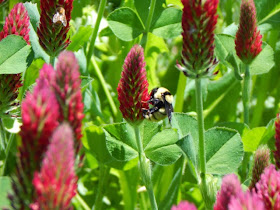Sam helping to get the smoker going
top bar hive
Langstroth hive
inside the top super of the Langstroth hive
honey bees on fresh white comb
We already knew that both packages were doing well. The queens were laying eggs and both colonies were already given more room to build comb so they could store their pollen and nectar. This evening we wanted to see if they had taken all the sugar syrup we made available and if they needed additional room.
Both hives drained their syrup so we added more. If there is plenty of nectar available in nature, bees prefer the real stuff and will ignore the syrup. The fact that they took it all told us that they were glad for the extra stores. We'd prefer that we didn't need to supplement in this way but after losing so many bees this past winter, we're apt to spoil them.
We saw plenty of brood, pollen and nectar in both hives.
capped brood- soon adult bees will emerge
nectar- when enough water has evaporated off, the bees will cap the finished honey
more capped brood and several cells of pollen (yellow)
Both hives were building new comb but the top bar colony built more. We added several empty bars to the top bar hive to let them continue building out. The Langstroth colony built a little but still has plenty of room in the top super so nothing was added to this hive.
new comb
Sometimes bees build comb in places that are inconvenient for us- like between frames, making it hard for us to do inspections. The comb needs scraping off with a hive tool.
Our hives are at the edge of a small wooded area with several black locust trees. This particular evening, the scent of their blooms was intoxicating. Honey bees love black locust nectar- something we didn't put together when we placed our hives.
They (and other native pollinators) also love clover. I wish we had fields and fields of these beautiful flowers.
It will be another couple busy weeks until we can check in on the bees again. Hopefully the extra space and food we gave them will keep them happy until the next time we can sneak out to the bee yard.





















Thanks for your bee "lesson". We are thinking about adding bees, but haven't really pursued it yet. I love your reminder comment.....your pickled beets would be safe from me! In fact, you could store them in my pantry and they wouldn't be touched....however green beans would not be safe! Have a great day! d
ReplyDeleteYou photos are amazing! The photos of the bees at the flowers are absolutely BEAUTIFUL!!
ReplyDeletePlease tell me you are eating those locust blossoms! They are SO delicious, but only good right around now for you folks (Ours aren't out until early June).
ReplyDeleteWe use the fruit batter recipe in the Joy of Cooking, and dip the blossoms in, fry them in a few inches of oil, and then dust with powdered sugar. Don't eat the fibrous end of the stem. :-). They taste similar to how they smell- completely intoxicating, similar to what rosewater or orange blossom water does for middle eastern recipes.
Why not do some cover crops of clover? It looks like you have crimson clover and the bees really like that. Our winters are to cold here usually for the crimson. My daughter and some of her cousins, all farmers, have taken over a hive operation of a retiring older couple and they have been building up patches of bee-friendly crops.
ReplyDeleteHi, there! The clover was an attempt at a cover crop but only a small patch came up for some reason. We'll try again for sure:-).
DeleteBeautiful Bee pictures! Fantastic photography. I love peaking into your pictures each week. - Carmen
ReplyDeleteWe've been wanting to start keeping bees!! I'm fairly certain that we live in the same area - I wanted to know if you would be willing to tell me where you get your bees, and which hives are best for starting up? Love these pictures!
ReplyDeleteAlison, email me and we can "talk" :-). thyhand123@gmail.com
Delete